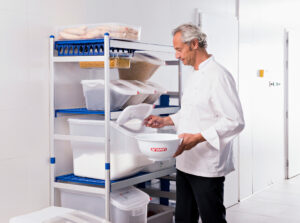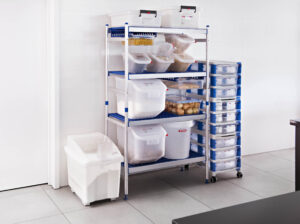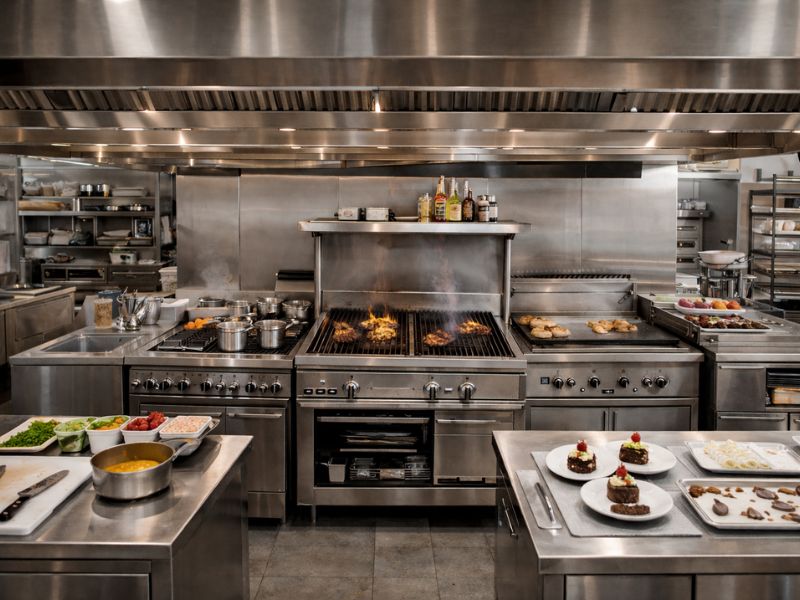Did you know that one of the most important areas of any restaurant is its storage area? The purpose of this space is to house all the items required for the business to operate successfully, which means that keeping it tidy is essential.
Because not all food expires at the same time or need refrigeration or freezing. You also need to take into account the demand for each item.
That’s why we need different types of storage options, both dry and refrigeration (cold storage), and freezing. However, this article will focus exclusively on dry storage. Find out how to manage restaurant storage. Optimise your space 100%.
Why is organisation important for a restaurant storage area?
A restaurant storage area is a transit area that is accessed daily. Consequently, the space must be tidy, clean and safe for optimum operation. These are some of the reasons for keeping it organised:
- Higher efficiency for the restaurant.
- More effective stock control.
- Limiting waste and, therefore, financial loss.
- Reducing food and beverage loss owing to expiry.
- Items become much easier to find.
- Stock rotation becomes more efficient.
- Faster restocking.
Eight ways to properly organise a restaurant storage area
The following eight tips will help you to more effectively manage the storage area for a restaurant kitchen.
1. Design a lay-out for the storage area
First of all, in order to learn how to organise a restaurant storage area, you need to start by designing its lay-out. And to do this, the best thing is to make a plan of the storage area that specifies the different sections, spaces and elements in it.
Mark where the catering racks and trolleys, walk-in fridges and freezer, entrance, etc. are located
2. Provide signage for storage areas
Just like in supermarkets, once you’ve laid out the storage area, you should place signage at the front of the racks to specify the food items or utensils that are being stored on it.
Because of the wide variety of items, which include tinned food, beverages, spices, cleaning products and pots and pans, among others, their organisation is essential.

3. Group group similar items together
It’s highly recommended that food items should be separated into groups by category, dividing them up according to the type of storage they require (you should be aware that a restaurant storage area will contain food that is both perishable and non-perishable).
Proper storage of food by category is very important for restaurants, given that the storage requirements for pulses are different to those of fish and meat, and we have to cater to all of them. For example, ingredient bins are a highly practical option.
4. Organise food items by date for effective storage at your restaurant
The golden rule is ‘first in, first out’ (FIFO), which means that the oldest stock always to be at the front with newer items behind them.
This is crucial if we want to avoid having to dispose of expired food. This limits food waste.
For this purpose, all the food items in the restaurant food storage area must be marked with the date they were stored there together with their expiry or best-before date.
5. Organise items by their rotation
Another rule when it comes to learning how to organise a restaurant storage area is to set aside a space for storing items with a high rotation rate. Logically, food items that the restaurant uses on a daily basis should be faster and easier to access.
And they are typically used according to the FIFO system.
6. Check humidity and temperature levels
Because we don’t want stored food to spoil, the space must be kept cool and dry, and good ventilation is required. The recommended temperature range is 10–20°C, with a relative humidity of 50–60%
In addition, its preservation is improved by using quality storage products, such as these square containers, which are ideal for storing bulk foods.
7. Take advantage of new technologies to keep control of your stock
What’s more, you should give a lot of thought to the use of new technologies for such essential tasks as stock control.
Regular stocktaking allows you to check the amounts and condition of the items kept in the storage area.
Likewise, implementing digitisation to automate tasks such as managing food storage at your restaurant optimises the efficiency of your staff. This requires the use of software to precisely monitor stock levels.
8. Don’t forget about cleanliness
Hygiene is essential when it comes to restaurant food storage. Food must be stored in ideal conditions, and any deficiencies in quality control can affect the health of your customers.
Both the storage area and wine cellar of a restaurant must be kept consistently clean, ventilated, tidy and free of pests or any other external agents.
In addition, their organisation must enhance cleanliness by facilitating and simplifying actions such as sweeping and mopping.

A tidy and clean storage area is essential for the efficiency of your restaurant
It’s evident that the success of a restaurant is directly proportional to the orderliness of its storage area. If the storage are is clean and tidy, in addition to offering quality food, the kitchen will operate much more quickly because all items will be accessible. And a fast kitchen is synonymous with satisfied customers.
It will also prevent waste for many items, particularly perishable foods, which will lead to cost savings in this regard.
At Araven we’re aware of the importance of having a restaurant storage area in perfect conditions. This is why we offer you the best professional food storage products. Although we specialise in products for cold storage, we also offer everything you need for dry food storage.
Visit our website today and discover our entire product range!




